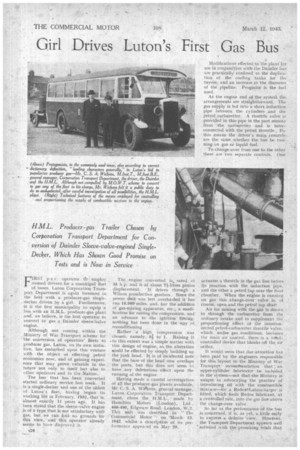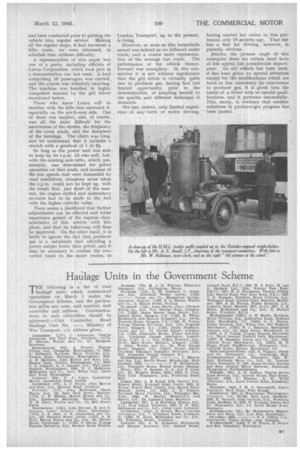Girl Drives Luton's First Gas Bus
Page 26

Page 27

If you've noticed an error in this article please click here to report it so we can fix it.
H.M.L. Producer-gas Trailer Chosen by Corporation Transport Department for Conversion of Daimler Sleeve-valve-engined
Single
Decker, Which Has Shown Good Promise on Tests and is Now in Service
pRST p.s.v. operator to employ women drivers for a municipal fleet of buses, Luton Corporation Transport Department is again foremost in • the field with a producer-gas singledecker driven by a girl. Furtherniore, it is the first municipality to equip a bus with an H.M.L. producer-gas plant and; we believe, is the first operator to convert to gas a Daimler sleeVe--Valve engine.
Although not coming within the Ministry of War Transport scheme for the conversion of operators' fleets to producer gas, Luton, on its own initiative, has embarked upon this venture with the object of effecting petrol economies now, and of gaining experience that may prove valuable in the future not only to itself but also to other olieeators and to the Nation: The bus that has been converted started ordinary service last week. It is a single-decker and one of the oldest of Luton's fleet, having begun its working life in February, 1932. that is, almost exactly 11 years ago. It has. been stated that the sleeve-valve engine is of a type that is not satisfactory with gas, but we can findno grounds for this view, and this operator already' seems to have disproved it %24 .... , The engine converted is rated, at 35 h.p. and is of about 71-litres piston displacement. It drives through a' Wilson preselective gearbox. Since the power &lit was last overhauled it has run 13,000miles, and, bar the addition of gas-mixing apparatus, etc., a modification for raising the compression, and an advance to the ignition timing, nothing has been done 'in the w,ay of reconditioning
Rather a high compression was chosen, namely, 91 to I. Raising it .to this extent was a 'simple matter with this design of engine, as the alteration eould be effected by simply building up the junk head. It is of incidental note that the base of the head now overlaps the ports. but this does not seem to have any deleterious effect upon the running of the engine.
Having made a careful investigation of all the producer-gas plants available, Mr. C. S. A. Witkens, general manager, Luton -Corporation Transport DepartMeat, chose the. H.M.L., made by Hamilton Motors (London), Ltd., 466-490, Edgware Road, London, W.2. This unit was described in " The 'Commercial Motor '• on March 13. 1942, whilst a description of its performance appeared on May 29.
Modifications effected to the plant or use in conjunCtion with the Daimler bus are practically confined to the duplication of the cooling tanks for the tuyere, and an increase in the diameter of the .pipeline. Progasite is the fuel used.
At the engine end of the systera the arrangements are straightforward. The gas supply is fed into a short induction pipe between, the cylinders and the petrol carburetter. A throttle valve is provided in this pipe in the part remote from the carburetter and is interconnected with the petrol throttle. By this means the driver's main controls. are the same whether the bus be running on gas or liquid fuel.
To change over from one to the other there are two separate controls. One
actuates a throttle in tlIe gas line before its junction with the induction pipe. and the other a petrol tap near the float chamber. When the engine is running on gas this change-over Valve is, of eourse, open and the petrol tap shut: Air for mixing with the gas is drawn in through the carburetter from the ordinary intake and to supplement the proportioning effect of the interconnected petrol-carburetter throttle valve, which, undue gas conditions, becomes the main air control, there is a controlled -device-device that blanks off the air orifice.
It would seem that due-attention has been paid by the engineers responsible for this layout to the Ministry of War Transport recommendation that an upper-cylihder lubricator be included in the system—not that the Ministry is unique in advocating the practice of introducing oil with the combustible mix tu re-for a Redex' Lubroc ha rger is fitted, which feeds Redex lubricant, at a controlled rate, into the gas line-above the change-over valve.
So far aS the performance of the bus is concerned, it is, as yet, a little early to express a definite 'view. However, the Transport Department appears well satisfied with the promising trials that had been conducted prior to putting the vehicle into regular service. Making all the regular stops, it had traversed a hilly route, we were informed, in schedule time without difficulty.
A representative of this paper was one of a party, including officials of Luton Corporation, which took part in a demonstration run last week. A load comprising 18 passengers was carried, and the course was definitely exacting. The machine was handled in highly competent manner by the girl driver mentioned before.
Those who know Luton will be familiar with the bills that surround it, especially on the north-east side. One of these was tackled, and, of course, was all the niore difficult for the narrowness of the streets, the frequency of the cross roads, and the sharpness of the turnings. The climb was long. and we understand that it includes a stretch with a gradient of 1 in 61.
So long as the power unit was able to keep up its r.p.m. all wbs well, but, with the existing axle ratio, which, presumably, was determined for petrol operation on that route, and because of the low speeds that were demanded by road conditions, occasions arose when the r.p.m. could not be kept up, with the result that, just short of the summit, the engine stalled and momentary recourse had to be made to the fuel with the higher calorific value.
There seems a likelihood that further adjustments can be effected and wider experience gained of the express characteristics of this vehicle with this plant, and that its behaviour will thus be improved. On the other hand, it is futile to ignore the fact that producer gas is a substitute fuel affording a power output lower than petrol, and it may be necessary to confine the converted buses to the easier routes, as London Transport, up to the present, is doing.
However, so soon as this formidable ascent was behind us we followed easier roads, and a course more representative of the average bus route. The performance of the vehicle thenceforward was exemplary. In this connection it is not without significance that the girl driver is virtually quite new to producer gas, having had but limited opportunity, prior to the demonstration, of adapting herself to the specific and different technique it demands. .
She has, indeed, only limited experience of any• form of motor driving, having started her career in this profession only 18 months ago. That she has a flair for driving, however, is patently obvious.
Besides the pioneer angle of this enterprise there are certain hard facts of less appeal but considerable importance. An old vehicle has been Used, it has been given no special attention except for the modifications which are more or less customary for conversion to producer gas, it is given into the hands of a driver with no special qualifications, and it performs successfully. This, surely, is evidence that another milestone in producer-gas progress has been passed.




























































